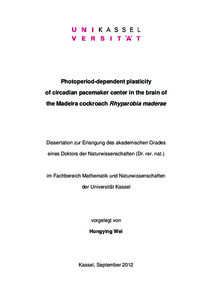| dc.date.accessioned | 2012-12-04T13:05:13Z | |
| dc.date.available | 2012-12-04T13:05:13Z | |
| dc.date.issued | 2012-12-04 | |
| dc.identifier.uri | urn:nbn:de:hebis:34-2012120442240 | |
| dc.identifier.uri | http://hdl.handle.net/123456789/2012120442240 | |
| dc.language.iso | eng | |
| dc.rights | Urheberrechtlich geschützt | |
| dc.rights.uri | https://rightsstatements.org/page/InC/1.0/ | |
| dc.subject.ddc | 500 | |
| dc.subject.ddc | 570 | |
| dc.title | Photoperiod-dependent plasticity of circadian pacemaker center in the brain of the Madeira cockroach Rhyparobia maderae | eng |
| dc.type | Dissertation | |
| dcterms.abstract | To various degrees, insects in nature adapt to and live with two fundamental
environmental rhythms around them: (1) the daily rhythm of light and dark, and (2) the yearly seasonal rhythm of the changing photoperiod (length of light per day). It is hypothesized that two biological clocks evolved in organisms on earth which allow them to harmonize successfully with the two environmental rhythms: (1) the circadian clock, which orchestrates circadian rhythms in physiology and behavior, and (2) the photoperiodic clock, which allows for physiological adaptations to changes in photoperiod during the course of the year (insect photoperiodism). The circadian rhythm is endogenous and continues in constant conditions, while photoperiodism requires specific light inputs of a minimal duration. Output pathways from both clocks control neurosecretory cells which regulate growth and reproduction. This dissertation focuses on the question whether different photoperiods change the network and physiology of the circadian clock of an originally equatorial cockroach species. It is assumed that photoperiod-dependent plasticity of the cockroach circadian clock allows for adaptations in physiology and behavior without the need for a separate photoperiodic clock circuit. The Madeira cockroach Rhyparobia maderae is a well established circadian clock model system. Lesion and transplantation studies identified the accessory medulla (aMe), a small neuropil with about 250 neurons, as the cockroach circadian pacemaker. Among them, the pigment-dispersing factor immunoreactive (PDF-ir) neurons anterior to the aMe (aPDFMes) play a key role as inputs to and outputs of the circadian clock system. The aim of my doctoral thesis was to examine whether and how different photoperiods modify the circadian clock system. With immunocytochemical studies, three-dimensional (3D) reconstruction, standardization and Ca2+-imaging technique, my studies revealed that raising cockroaches in different photoperiods changed the neuronal network of the circadian clock (Wei and Stengl, 2011). In addition, different photoperiods affected the physiology of single, isolated circadian pacemaker neurons. This thesis provides new evidence for the involvement of the circadian clock in insect photoperiodism. The data suggest that the circadian pacemaker system of the Madeira cockroach has the plasticity and potential to allow for physiological adaptations to different photoperiods. Therefore, it may express also properties of a photoperiodic clock. | eng |
| dcterms.accessRights | open access | |
| dcterms.creator | Wei, Hongying | |
| dc.contributor.corporatename | Kassel, Universität, FB 10, Mathematik und Naturwissenschaften, Institut für Biologie | |
| dc.contributor.referee | Stengl, Monika (Prof. Dr.) | |
| dc.contributor.referee | Helfrich-Förster,Charlotte (Prof. Dr.) | |
| dc.subject.swd | Leucophaea maderae | ger |
| dc.subject.swd | Nervennetz | ger |
| dc.subject.swd | Tagesrhythmus | ger |
| dc.subject.swd | Licht | ger |
| dc.subject.swd | Schrittmacher | ger |
| dc.subject.swd | Biologische Uhr | ger |
| dc.date.examination | 2012-11-05 | |

